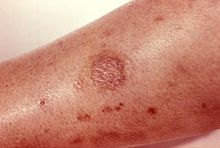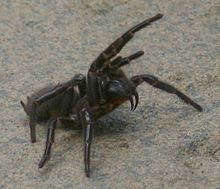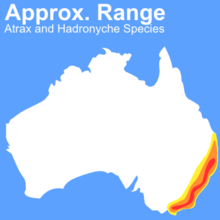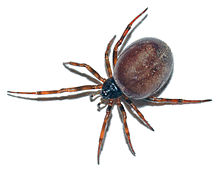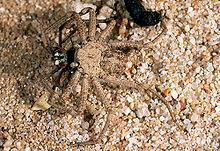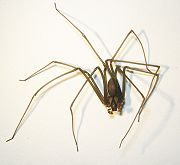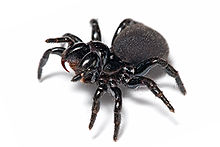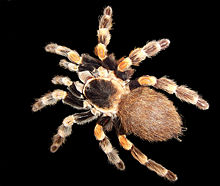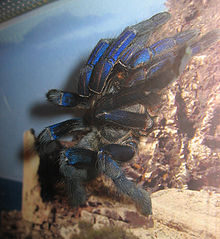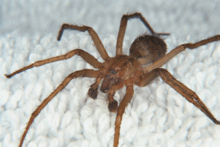- Spider bite
-
"Spider bite" redirects here. For The Spider Bite urban legend, see The Spider Bite.
Spider bite Classification and external resources 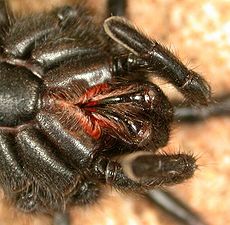
Chelicerae of a black wishbone (nemesiid) spider, a mygalomorphICD-10 T14.1, T63.3, W57 (nonvenomous), X21 (venomous) ICD-9 989.5, E905.1, E906.4 DiseasesDB 12299 MedlinePlus 002858 eMedicine article/772484 A spider bite is an injury resulting from the bites of spiders or other closely related arachnids.
Spiders are active hunters and rely heavily on their bites to paralyze and kill their prey before consuming it. They also bite in self defense. While many spiders will never attack animals larger than themselves, some exhibit a rather aggressive behavior and will stand their ground when approached by larger animals, e.g., Atrax robustus. Most spider bites, however, occur when humans unintentionally press up against spiders and receive a defensive bite. On rare occasions, spiders may make prey mistakes and bite a human finger or other body part as though it were a caterpillar or other such insect.
Only spiders of fairly large species possess chelicera long enough to penetrate human skin. There is nothing smaller than members of the Cheiracanthium genus (around 6 mm.) that gives a bite that is greatly troublesome to humans. The effect of a bite on humans is dependent on both the toxicity of the venom and the amount of venom. About 98% of the bites inflicted by species that are large enough that their bites are noticed will have no serious medical consequences.[1] Of those bites that humans notice, venoms can include necrotic agents, neurotoxins, and agents such as serotonin. Only some two hundred species in twenty genera (out of over 40,000 known species) are known to have serious, potentially lethal bites.[2]
In most cases of bites, the chief concern is the spider's venom, although in some cases medically non-significant spiders can transmit infectious diseases. Spiders regarded as dangerous possess venom that is sufficiently toxic to humans that a single bite can deliver a medically significant dose. Only three spider families are known to be non-venomous, i.e. lacking venom glands. They are Uloboridae, Holarchaeidae and Liphistiidae. The Liphistiidae, however, are large enough to deliver unpleasant bites. In addition, their fangs can often inflict infections spread through the skin, mostly due to their large size, which in theory could represent more danger than the bite of a non-lethal venomous spider species.
Spider bites may be misdiagnosed by both the general public and medical practitioners. Many other conditions both infectious and non-infectious can be confused with spider bites.[3] Many of these conditions are far more common and more likely to be the source of necrotic wounds.[4]
Contents
- 1 Signs and symptoms
- 2 Pathophysiology
- 3 Diagnosis
- 4 Management
- 5 Epidemiology
- 6 Classification
- 7 See also
- 8 References
- 9 External links
Signs and symptoms
Pain from non-venomous spider bites typically lasts for 5 to 60 minutes while pain from venomous spider bites frequently lasts for longer than 24 hours.[5] The rate of a bacterial infection due to a spider bite is low (0.9%).[5]
Pathophysiology
A primary concern of the bite of a spider is the effect of its venom. A spider envenomation occurs whenever a spider injects venom into the skin. Not all spider bites involve injection of venom into the skin, and the amount of venom injected can vary based on the type of spider and the circumstances of the encounter. With very few exceptions, such as the so-called camel spider (which is not a true spider), the mechanical injury from a spider bite is not a serious concern for humans. Some spider bites do leave a large enough wound that infection may be a concern, and other species are known to consume prey which is already dead, which also may pose a risk for transmission of infectious bacteria from a bite.[6] However, it is generally the toxicity of spider venom that poses the most risk to human beings; several spiders are known to have venom which can be fatal to humans in the amounts that a spider will typically inject when biting.
All spiders are capable of producing venom, with the exception of the hackled orb-weavers, the Holarchaeidae, and the primitive Mesothelae. (Other arachnids often confused with spiders, such as the harvestman and sun spiders, also do not produce venom). Nonetheless, only a small percentage of species have bites that pose a danger to people. Many spiders do not have mouthparts capable of penetrating human skin. While venoms are by definition toxic substances, most spiders do not have venom that is sufficiently toxic (in the quantities delivered) to require medical attention and, of those that do, only a few are known to produce fatalities. (For details that substantiate these claims, see the remainder of this article.)
Spider venoms work on one of two fundamental principles; they are either neurotoxic (attacking the nervous system) or necrotic (attacking tissues surrounding the bite, and, in some cases, attacking vital organs and systems).
Neurotoxic venom
The majority of spiders with serious bites possess a neurotoxic venom of some sort, though the specific manner in which the nervous system is attacked varies from spider to spider.[7][8][9]
- Widow spider venom contains components known as latrotoxins, which cause the release of the neurotransmitter acetylcholine, stimulating muscle contractions. This can affect the body in several ways, including causing painful abdominal cramps, as well as interfering with respiration, and causing other systemic effects.[2]
- The venom of Australasian funnel-web spiders and mouse spiders works by opening sodium channels, causing excessive neural activity which interferes with normal bodily function.
- The venom of Brazilian wandering spiders is also a potent neurotoxin, which attacks multiple types of ion channels [10] In addition, the venom contains high levels of serotonin, making an envenomation by this species particularly painful.
Necrotic venom
Spiders known to have necrotic venom are found in the family Sicariidae, a family which includes both the recluse spiders and the six-eyed sand spiders. Spiders in this family possess a known dermonecrotic agent sphingomyelinase D,[11][12] which is otherwise found only in a few pathogenic bacteria.[13][14] Some species in this family are more venomous than others; according to one study, the venom of the chilean recluse and several species of six-eyed sand spider indigenous to southern Africa, contains an order of magnitude more of this substance than do other Sicariidae spiders such as the brown recluse.[15] Bites by spiders in this family can produce symptoms ranging from minor localized effects, to severe dermonecrotic lesions, up to and including severe systemic reactions including renal failure, and in some cases, death.[16] Even in the absence of systemic effects, serious bites from Sicariidae spiders may form a necrotising ulcer that destroys soft tissue and may take months and very rarely years to heal, leaving deep scars. The damaged tissue may become gangrenous and eventually slough away. Initially there may be no pain from a bite, but over time the wound may grow to 10 inches (25 cm) in extreme cases. Bites usually become painful and itchy within two to eight hours, pain and other local effects worsen 12 to 36 hours after the bite, and then necrosis will develop over the next few days.[17]
Serious systemic effects may occur before this time, because the venom spreads throughout the body in minutes. Mild symptoms include nausea, vomiting, fever, rashes, and muscle and joint pain. Rarely more severe symptoms occur including hemolysis, thrombocytopenia, and disseminated intravascular coagulation.[18] Debilitated patients, the elderly, and children may be more susceptible to systemic loxoscelism. Deaths have been reported for both the brown recluse and the related South American species L. laeta and L. intermedia.
Numerous other spiders have been associated with necrotic bites in the medical literature. Examples include the Hobo spider and the Yellow Sac spider. However, the bites from these spiders are not known to produce the severe symptoms that often follow from a recluse spider bite, and the level of danger posed by each has been called into question.[19][20] So far, no known necrotoxins have been isolated from the venom of any of these spiders, and some arachnologists have disputed the accuracy of many spider identifications carried out by bite victims, family members, medical responders, and other non-experts in arachnology. There have been several studies questioning whether danger is posed by some of these spiders. In these studies, scientists examined case studies of bites in which the spider in question was positively identified by an expert, and found that the incidence of necrotic injury diminished significantly when "questionable" identifications were excluded from the sample set.[21][22]
Comparative analysis
It is often asked which type of spider is the most "dangerous" in the world. There isn't a simple answer to this question, as there are many things which must be taken into account when considering the amount of danger posed by spider bites:
- Firstly, it is often the case that a spider bite is "dry" – the skin may be pierced, but little or no venom is injected into the victim. In such an instance, little or none of the spider's dangerous potential for harm is manifested.
- Secondly, there have been reports of spider bites (by spiders considered otherwise harmless) causing allergic reactions in some individuals, up to and including anaphylactic shock, a life-threatening condition (much the same as a sting from an ant, bee, or wasp may produce a harmful effect apart from the toxic quality of its venom).[23]
- Thirdly, many spiders listed as dangerous are seldom encountered, or have dispositions that make them unlikely to bite despite the high toxicity of their venom.
- Finally, little is known about the toxicity of many spiders, due to their infrequent encounters with humans; the list of venomous spiders is limited to those that are linked to medical events in humans or who otherwise have been extensively studied.
It should also be noted that, for healthy adults, a bite by even the most toxic spiders on the list may require hours before death ensues; if timely appropriate emergency medical treatment is administered, victims may be expected to recover. The scenario given in movies such as Arachnophobia, where bite victims die within minutes, does not occur. One exception to this picture occurs in the case of very small children because the amount of venom dispersed throughout the body is many times the concentration in an adult. There is at least one recorded case of a small child dying within 15 minutes of a bite from a Sydney funnel-web spider; that event occurred before the development of an antivenom. Since the antivenom was developed there have been no fatalities due to this species.
The spider-bites documented as the most dangerous to humans are those of the Sydney funnel-web spider and the Brazilian wandering spider. These spiders are potentially more dangerous than widow spiders because they have longer fangs and can inject greater quantities of venom to greater depths. Phoneutria nigriventer has approximately 2 mg of venom, but frequently gives dry bites or at least does not deliver all of its available venom. Atrax robustus has approximately 1.7 mg of venom. Bites of Six-eyed sand spiders have been described as dangerous to humans, but there is a lack of proof for this,[24]:p.25 though Sicarius venom has been shown to be fatal to rabbits.
The genus Latrodectus (of which the black widow spider is the most notorious) have been credited with killing more people per year, worldwide, than any other spider. Because they are not very large, they are much harder to detect than a large Brazilian wandering spider or a tarantula. Their venom is extremely potent. Compared to many other species of spiders, their chelicerae are not very large. In the case of a mature female, the hollow, needle shaped part of each chelicera, the part that penetrates the skin, is approximately 1 mm (0.04 in) long, sufficiently long to inject the venom to a dangerous depth. The males, being much smaller, can inject far less venom and inject it far less deeply. The actual amount injected, even by a mature female, is very small in physical volume (.02–.03 mg). When this small amount of venom is diffused throughout the body of a healthy, mature human, it usually does not amount to a fatal dose. Deaths in healthy adults from Latrodectus bites are rare in terms of the number of bites per thousand people. Only sixty-three deaths were reported in the United States between 1950 and 1989 (Miller, 1992). On the other hand, the geographical range of the widow spiders is very great. As a result, far more people are exposed, worldwide, to widow bites than are exposed to bites of more dangerous spiders, so the highest number of deaths worldwide are caused by members of the genus Latrodectus. Widow spiders have more potent venom than most spiders, and prior to the development of antivenom, 5% of bites resulted in fatalities, although comparable figures are not available for the other species.[25]
Measurements
The LD-50 (Median lethal dose) figures have limited utility since the effects of venoms differ widely from species to species. Before an antivenom was developed, deaths from Atrax and Hadronyche did occur, but the frequency of non-lethal bites is unknown. Some deaths from Phoneutria bites are reported, but much of their range is in the Amazon so reporting of bites may not be very complete.
Most LD-50 figures are based on experiments with laboratory mice. There are great differences in the sensitivities of various kinds of organisms to various kinds of venom. The relative sensitivities of mice to various venoms may not allow prediction of the exact degree of human sensitivity. So most of these figures can only give a rough approximation of the medical consequences of various spider bites to humans. A case in point are the Sicarius spp. The venom of these spiders is extremely active in laboratory animals, but there are few if any documented reports of Sicarius bites in humans, so data on which to base valid conclusions is lacking.
Genus Species Common name Body length Venom amount LD-50 Alternate LD-50 Deaths reported Atrax robustus Sydney funnel-web spider 24–32 mm.[23] 0.25 mg (F) and 0.81 mg (M) [26] 2 mg [27] .16 mg/kg [28] unknown 1927–1980 13 deaths[29] Hadronyche formidabilis Northern tree funnel-web spider 23–45 mm. Latrodectus mactans Black widow 8–15 mm [23] 0.02–.03 mg.[30][31] 0.002 mg/kg [30]* 0.9 mg/kg 5% of reported bites prior to antivenom availability [23] Latrodectus tredecimguttatus Malmignatte (approx. same) (approx. same) 0.68 μg/kg [32] 16.25 μg/kg [32] Loxosceles reclusa Brown recluse 1.2 cm (0.75 in) [23] 6–10 mm [23] .13–.27 mg.[32][33] (rare) [23] Loxosceles intermedia 0.48 mg/kg [34] unknown Loxosceles laeta Chilean recluse 1.45 mg/kg [34] Loxosceles gaucho 0.74 mg/kg [34] Phoneutria bahiensis Brazilian wandering spider 30 mm 1.079 mg [35] .00061–.00157 mg/kg [35] Phoneutria boliviensis Brazilian wandering spider 30 mm 1.079 mg.[35] .00061–.00157 mg/kg [35] Phoneutria fera Brazilian wandering spider 30 mm [23] 1.079 mg [35] .00061–.00157 mg/kg [35] occasional deaths even after antivenin treatment[23] Phoneutria nigriventer Brazilian wandering spider 3–5 cm (1.25–2 in) [36] 2.15 mg [33] 1.079 mg.[35] 15.20 ng/mg.[33] 00061–.00157 mg/kg [35] 200 µg/kg (0.2 ng/mg) [33] Phoneutria reidyi Brazilian wandering spider 30 mm .00061–.00157 mg/kg [35] 0.3 mg/kg Sicarius (Africa & S.A. species) Six-eyed sand spider 17 mm Haplopelma huwenum (previously Selenocosmia huwena) Chinese bird spider 0.70 mg/kg [37] Poecilotheria ornata Fringed ornamental tarantula Instances of coma reported.[38] Poecilotheria fasciata ** Sri Lankan ornamental tarantula Instances of cardiac failure reported [38] Cheiracanthium species Yellow Sac spider 6–10 mm (No severe consequences) [23] Cheiracanthium japonicum Japanese sac 6–10 mm Macrothele holsti, gigas, taiwanensis [31] Primitive burrowing spiders No deaths reported in Taiwan.[39] Steatoda grossa Cupboard spider Mild widow-like symptoms reported, no severe consequences * This value is based on experience with human exposures.
** Several other kinds of tarantulas in the pet trade are regarded as giving non-trivial bites. Tarantulas are typically far larger than spiders with the most toxic kinds of venom. However, the sheer volume of the venom may compensate for its lesser toxicity. The effects of a full envenomation are probably unknown for many species of tarantulas, so due caution is advisable.Diagnosis
Assumption that a reported injury was caused by a spider is the most common source of false reports, which in some cases have led to misdiagnosis and mistreatment, with potentially life-threatening consequences.[40] Many spider bites, including those by some dangerous species, are relatively painless at first and may go unnoticed if not directly observed. These bites may only be noticed later if serious symptoms appear.
Occasionally, infections of methicillin-resistant Staphylococcus aureus (MRSA) are misdiagnosed as necrotic spider bites; this can have severe consequences as a MRSA infection is frequently a medical emergency.[41]
Management
Most spider bites are harmless, and require no specific treatment. Treatment of bites may depend on the type of spider; thus, capture of the spider—either alive, or in a well-preserved condition, is useful.[citation needed]
In the case of bites by widow spiders, Australian venomous funnel-web spiders, or Brazilian wandering spiders, prompt medical attention should be sought as in some cases the bites of these spiders may develop into a medical emergency.[citation needed]
Treatment for non-poisonous spider bites include washing the bite with soap and water and ice to reduce inflammation.[5] Analgesics and antihistamines may be used, however antibiotics are not recommended unless there is also a bacterial infection present.[5]
Necrosis
There is no established treatment for necrosis. Recommendations include elevation and immobilization of the affected limb, application of ice, local wound care, and tetanus prophylaxis. Many other therapies have been used with varying degrees of success including hyperbaric oxygen, dapsone, antihistamines (e.g., cyproheptadine), antibiotics, dextran, glucocorticoids, vasodilators, heparin, nitroglycerin, electric shock, curettage, surgical excision, and antivenom. None of these treatments have been subjected to controlled, randomized trials to conclusively show benefit. In almost all cases, bites are self-limited and typically heal without any medical intervention.[4]
Dapsone is commonly used in the USA and Brazil for the treatment of necrosis. There have been conflicting reports about its efficacy and some have suggested it should no longer be used routinely, if at all.[42]
Other
- Studies have shown surgical intervention is ineffective and may worsen outcome. Excision may delay wound healing, cause abscesses, and lead to objectional scarring.[43]
- Use of antivenom for severe spider bites may be indicated, especially in the case of neurotoxic venoms.[44] Effective antivenoms exist for Latrodectus, Atrax, and Phoneutria venom. Recluse bites are treatable by antivenom; an antivenom for Loxosceles bites is available in South America, and it appears antivenom may be the most promising therapy. However, the recluse antivenom is most effective if given early, and because of the relatively painless bite delivered by recluses, patients do not often present until 24 or more hours after the event, possibly limiting the effect of this intervention.[45] Due to the risk of serum sickness, use of antivenom is generally not indicated unless serious symptoms are present, and/or a person fails to respond to other forms of treatment.
Epidemiology
Australia
A study of 750 definite spider bites in Australia indicated that 6% of spider bites cause significant effects, the vast majority of these being redback spider bites causing significant pain lasting more than 24 hours.[46]
United States
The jumping spider is probably the most common biting spider in the United States,[47] the main species being Phidippus audax.[48] Bites from a jumping spider are usually painful, itchy and cause redness and significant swelling.[47]
The spiders of most concern in the United States, however, are brown recluse spiders and black widow spiders. Most recluse spider bites are minor with little or no necrosis. However, a small number of bites produce severe dermonecrotic lesions, and, sometimes, severe systemic symptoms, including organ damage. Rarely the bite may also produce the systemic condition with occasional fatalities.
Black widow spider bites may cause muscle cramps, but no one in the United States has died from a black widow spider bite in over 10 years.[47]
Classification
A spider is classified as "venomous" if it is able to cause significant harm to humans.[5] Spiders having medically significant venom exist in all but the coldest parts of the world. There is general agreement on which spiders give bites that may produce lasting damage or death, but not such general agreement on how one might sort spiders identified by genus and species in order of their threat to humans.
The following types of spider are known to have medically significant bites, with symptoms ranging from localized pain all the way to severe tissue destruction and potential death. Spiders whose bites have caused fatalities which are well documented in the scientific literature are so indicated in the section headers. Only four genera (Phoneutria, Atrax, Latrodectus, and Loxosceles) are known to have killed humans; three other genera (Hadronyche, Missulena, and Sicarius) possess venom which toxicology studies have shown have lethal potential (being similar to Atrax and Loxosceles venom in composition).[citation needed] There are suspected but unconfirmed deaths reported in the literature from species in Tegenaria and Haplopelma.[citation needed]
Brazilian wandering spiders
Main article: Brazilian wandering spider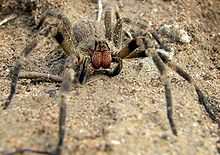 Brazilian wandering spider (Phoneutria nigriventer).
Brazilian wandering spider (Phoneutria nigriventer).
The Brazilian wandering spider (a ctenid spider) is a large brown spider similar to North American wolf spiders in appearance, although somewhat larger. It has a highly toxic venom (the most neurologically active of all spiders), and is regarded (along with the Australian funnel-web spiders, whose bites deliver slightly less venom, but are faster-acting) as among the most dangerous spiders in the world.[49]
Brazilian wandering spiders, like their name says, are active hunters and travel a lot. They tend to crawl into cozy, comfortable places for the night, and thus can easily be found in fruits and flowers that humans consume and cultivate. If the spider has a reason to be alarmed, it will bite in order to protect itself, but unless startled or enraged, most bites will be delivered dry (i.e. without venom). Venom bites will occur if the spider is pressed against something (such as fingers) and hurt. In this case, the high levels of serotonin contained in the venom, plus at minimum strong chelicera, will contribute to deliver a very painful bite that can result in muscle shock.
Children are more sensitive to the bites of wandering spiders, as the spiders often make threat gestures (such as raising up their legs, or hopping sideways on the ground), which might amuse a child to the point of reaching towards the spider. Children have weaker immune systems, and even if antivenom is quickly administered, death can occur within minutes after the bite[citation needed]. In male humans, bites of this spider may also result in priapism. Scientists are attempting to create an erectile dysfunction treatment that can be combined with other medicines out of the peptide that causes this reaction.[50]
Australian funnel-web spiders
Main article: Australian funnel-web spidersThe Australian funnel-web spiders, such as the Sydney funnel-web spider Atrax robustus (a mygalomorph only distantly related to the araneomorph funnel-web spiders) are regarded as among the most dangerous in the world. They react vigorously to threats and, reputedly, will more often attempt to bite than run away. A. robustus, a large black spider, is found within a radius of about 100 km from Sydney. Its venom contains a compound known as atracotoxin which is highly toxic to primates. Unlike the Brazilian wandering spider, which is alleged to occasionally deliver dry bites, these spiders typically deliver a full envenomation when they bite.[citation needed]
A. robustus is one of three designated species of the genus Atrax.[51][52] The related genus Hadronyche is represented by about 40 other dangerous species in eastern Australia, including Queensland and Tasmania. The males in this case have somewhat more potent venom than females and they also wander, making them more likely to be encountered in summer. Bites by males of two large species, the Sydney funnel-web and northern tree funnel-web, have resulted in death.[53]
One other genus in the Hexathelidae family has been reported to cause severe symptoms in humans. Severe bites have been attributed to members of the genus Macrothele in Taiwan, but no fatalities.[39]
Tangle-web spiders
Two genera of the tangle web spiders have venom which is known to be medically significant. One genus, the widow spiders of genus Latrodectus, has caused more human fatalities than any other. The other genus, the false widow spiders of Steatoda, has a far less serious bite.
Widow spiders
Main article: Widow spider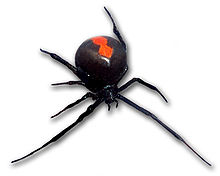 Latrodectus hasselti, the Redback spider
Latrodectus hasselti, the Redback spider
The widow spiders (genus Latrodectus), such as the black widow, redback spider, and katipo are spiders that carry a neurotoxic venom[54] which can cause a set of symptoms known as Latrodectism.
Like many spiders, widows have very poor vision, and they move with difficulty when not on their web. Widow spiders are large, strong-looking house spiders (but still have relatively spindly legs and deep, globular abdomens). The abdomen is dark and shiny, and has one or several red spots, either above or below. The spots may take the form of an hourglass, or two triangles, point-to-point. Male widows, like most spider species, are much smaller than the females and may have a variety of streaks and spots on a browner, less globular abdomen. The males are generally less dangerous than the females of the same species. Widows tend to be non-aggressive, but will bite if the web is disturbed and the spider feels threatened.
The venom, while seldom life-threatening, produces very painful effects including muscle spasms, 'tetanus-like' contractions and, in some cases, spinal or cerebral paralysis (which is generally temporary, but might leave permanent damage to central nervous system). A serious bite will often require a short hospital stay. Children, elderly, and ill individuals are at most risk of serious effects.
False black widows
Main article: SteatodaThe False black widow spiders (also known as false katipo, false button spider, cupboard spider, and in Australia, brown house spider) are spiders of the genus Steatoda. They resemble widow spiders in size and physical form, due to being members of the same family. While the bite of Steatoda spiders is nowhere near as serious as that of true widow spiders, several of these spiders do have medically significant bites. The bite of Steatoda grossa, commonly known as the cupboard spider, is known to cause symptoms which have been described as a very minor widow bite; the medical community now refers to the symptoms of Steatoda bites as steatodism. Other spiders in this genus known to be problem biters include two chiefly European varieties, S. paykulliana and S. nobilis, and a species found mainly in New Zealand and South Africa, S. capensis
Use of widow spider antivenom has been shown effective in treating steatodism.[55] The genera Steatoda and Latrodectus are biologically close cousins; both belong to the family Theridiidae. There are over 100 species in this genus, but only several species have been associated with medically significant bites.
Members of this genus are characterized by the "D" shape of the cephalothorax, and the way the relatively straight line thus formed is mirrored by the blunt forward surface of the abdomen. Other genera in this family generally have cephalothoraxes that are more oval in shape or even rather round, and that give the appearance of two body parts that are joined by a small connector.
Sicariidae spiders
The family Sicariidae includes two genera which inflict necrotoxic bites. One genus, Loxosceles, comprises the recluse spiders (below). The other genus, Sicarius is found only in the southern hemisphere, an example being the Six-eyed sand spider, Sicarius hahni
Six-eyed sand spiders
Main article: Six-eyed sand spiderThe six-eyed sand spider, of southern Africa and others of the genus Sicarius inject a cytotoxic venom, believed to contain sphingomyelinase D,[citation needed] for which there is currently no antivenom. Fortunately, this specimen rarely interacts with humans, and is seldom known to bite. This spider buries itself in sand in order to ambush prey that wanders nearby. Sand particles adhere to cuticles on its abdomen, thus acting as a natural camouflage if uncovered. If disturbed, it will run a short distance and bury itself again.
Recluse spiders
Main article: Recluse spiderRecluse spiders (Loxosceles spp.), such as the brown recluse spider, also known as "violin spiders," "fiddlers," or "fiddlebacks," from the dark violin-shaped marking on the cephalothorax, are slow-moving, retiring spiders which wander about in dim areas and under things, and so are more easily trapped against one's skin by clothing, bed sheets, etc. The spiders will often creep along at a very slow pace and then make a sudden dart for a couple of inches, then return to the previous languid pace. Recluses are extremely venomous. Most encounters with this spider occur from moving boxes or rooting about in closets or under beds. The range of the brown recluse, L. reclusa in the US is approximately the southern two-thirds by the eastern three-quarters of the country. A number of related recluse spiders (some non-native introductions) are found in southern California and nearby areas.[citation needed]
Most recluse spider bites are minor with little or no necrosis. However, a small number of bites produce severe dermonecrotic lesions, and, sometimes, severe systemic symptoms, including organ damage. Rarely the bite may also produce the systemic condition with occasional fatalities.
A minority of bites form a necrotizing ulcer that destroys soft tissue and may take months and, on very rare occasions, years to heal, leaving deep scars similar to MRSA. The damaged tissue will become gangrenous and eventually slough away. The initial bite frequently cannot be felt and there may be no pain, but over time the wound may grow to as large as 10 inches (25 cm) in extreme cases. Bites usually become painful and itchy within 2 to 8 hours, pain and other local effects worsen 12 to 36 hours after the bite with the necrosis developing over the next few days.[17]
Serious systemic effects may occur before this time, as the venom spreads throughout the body in minutes. Mild symptoms include nausea, vomiting, fever, rashes, and muscle and joint pain. Rarely more severe symptoms occur including hemolysis, thrombocytopenia, and disseminated intravascular coagulation.[18] Debilitated patients, the elderly, and children may be more susceptible to systemic loxoscelism. Deaths have been reported for both the brown recluse and the related South American species L. laeta and L. intermedia.[citation needed]
Even more dangerous is the Chilean recluse, a species native to South America and found in many parts of the world, including in southern California and other southwestern states. Bites of this spider have been known to cause systemic reactions in 15% of reported cases, and fatalities in 3-4% of cases.[56]
Mouse spiders
Main article: mouse spiderThe mouse spiders of the genus Missulena are a type of primitive burrowing spider found primarily in Australia. Several species of this genus are known to possess a venom which contains compounds similar to atracotoxin, the substance in funnel-web venom which is deadly to humans, and there have been several recorded bites by this spider producing severe symptoms requiring emergency medical treatment. However, unlike the funnel-web spiders, which have resulted in at least 13 deaths in the last 100 years,[57] there are no recorded human fatalities due to mouse spider bites, and many bites by this spider result in no serious complications. It is suspected that unlike Atrax and Hadronyche, which typically deliver full envenomations when they bite, that mouse spiders often give "dry" bites. When severe envenomation does occur, funnel-web antivenom has been shown to be effective.[58]
Tarantulas
Main article: TarantulaThe tarantulas of the family Theraphosidae are fearsome-looking spiders with (sometimes justified) reputations for inflicting harm. As large spiders, they have very powerful fangs and are capable of delivering a sizable quantity of venom. However, many tarantula species are known to be relatively harmless to humans.
New-world tarantulas
New-world tarantulas—those indigenous to the Americas—have bites that generally pose little threat to humans (other than causing localized pain). The primary defense deployed by these spiders is by means of urticating hairs, which can cause irritant symptoms in humans.
Old-world tarantulas
Old-world tarantulas, especially those indigenous to Asia, lack urticating hairs and use biting as a defensive mechanism as well for subduing prey. They are far less docile than new-world tarantulas, and are more likely to bite when provoked. Incomplete studies of old-world tarantula venoms, as well as anecdotal evidence, suggests that they are more potent than those of new-world counterparts.[citation needed]
There have been reports of significant bites by Poecilotheria species, occasionally resulting in hospitalization. Symptoms include localized pain and swelling, exhaustion, moderate to severe muscle cramping, labored breathing and fever, sometimes delayed days after the initial bite.[59][60][61][62]
One tarantula whose venom has been studied extensively is the Chinese bird spider, a tarantula of the subfamily Ornithoctoninae. The venom has been found to contain numerous novel toxins, is effective at killing mice, and has been blamed for at least one fatality in China.[citation needed] However, there is little documented clinical evidence of the effects of this spiders' bite in humans, so firm conclusions about the level of danger posed by this spider cannot be drawn.
Yellow Sac spiders
 Yellow Sac spider Cheiracanthium punctorium
Yellow Sac spider Cheiracanthium punctorium Main article: Yellow sac spider
Main article: Yellow sac spiderThe Yellow Sac spiders, Cheiracanthium sp., take shelter in silk tubes during the daytime and generally come out to hunt at night.[citation needed] These pale yellow or whitish spiders are often found in houses at the top of walls, or wandering across ceilings. They are also commonly found outdoors on foliage. The draglines they leave while hunting are one of the most common "spiderwebs" that are removed with broom and vacuum cleaner. People may unintentionally make contact with them in the dark and so be bitten if the spider is irritated or provoked. However, many people will live their entire lives in close proximity to them and never suffer a bite. Nevertheless, the spider's bite is considered toxic.[citation needed]
Others
There are several species of spider (and a few other arachnids which are not spiders, but are frequently confused with them), who have had unsupported reputations for being harmful to humans. In some cases, that the species is now considered harmless is a settled matter for arachnologists and other professionals; in other cases (such as the hobo spider), prior scientific belief that a spider is harmful to humans is now being questioned.
Hobo spiders
Main article: Hobo spiderThe hobo spider, Tegenaria agrestis, may wander away from its web, especially in the fall, and thus come into contact with people and potentially bite. This spider is found in the northwestern United States, western Canada and throughout much of Europe. Studies performed by arachnologist Darwin Vest reported that this spider's venom caused significant necrotic effects in laboratory animals,[63][64] and medical authorities in the Pacific Northwest who were aware of Vest's research subsequently blamed this spider for at least one fatality. Many agricultural authorities have published the advice that this species is potentially harmful, and medical personnel in the western United States and Canada have been advised to consider hobo spider bites when patients present with necrotic wounds. Many brown recluse bites have been reported in the U.S. west coast states (Washington, Oregon, and northern California) where populations of brown recluse spiders have not been found; some of these alleged bites have been attributed to hobo spiders instead.[40]
However, in Europe, where the spider originates, the species is considered a harmless outdoor relative of the common house spider (Tegenaria domestica), and no other spider in the genus Tegenaria is considered to be harmful to people. Attempts to replicate Vest's study that reported necrotic effects of the venom have failed, thus casting the "dangerous" status of this spider into doubt. In addition, Vest's methodologies have been questioned; he has been accused of incorrectly attributing symptoms to hobo spider bites when no positive identification of the spider was made. The one fatality attributed to the spider by medical authorities has also been questioned, and there are no documented cases where an otherwise-healthy person has developed a necrotic lesion from a positively-identified hobo spider bite. Many scientists now question whether or not the spider is harmful at all.[65][66]
Lycosa tarantula
 Lycosa tarantula. Its back is covered with recently hatched spiderlings.
Lycosa tarantula. Its back is covered with recently hatched spiderlings.
Lycosa tarantula, a species of wolf spider which is found near Taranto, Italy, Serbia, Montenegro (and the origin of the name tarantula, which today refers to a completely different kind of spider), was once blamed for a condition known as tarantism. Workers in the fields would suffer bites, and observe large, conspicuous, hairy spiders in the area. That spider, L. tarantula, was blamed for the pain and suffering (and occasional death) associated with tarantism. It is known that the bite of L. tarantula, while sometimes painful, has no serious medical consequences for humans. It is also suspected that the real culprit was another spider, Latrodectus tredecimguttatus, a type of widow spider, and one which is now known to be very dangerous to people.
White-tailed spiders
White-tailed spiders (Lampona spp.), indigenous to Australia and present as an invasive pest in New Zealand, have been blamed for a necrotic bite, producing symptoms similar to a brown recluse. However, a scientific study published in 2003 showed that their bites produce pain equivalent to a bee sting, a red mark, local swelling and itchiness; very occasionally nausea, vomiting, malaise or headache may occur. The study of 130 white-tailed spider bites found no necrotic ulcers or confirmed infections.[21]
Harvestman
The spider-like arachnids known as Opiliones (also known as "harvestmen" or "daddy-long-legs"), are a species often handled by humans. They are the subject of an urban legend which not only claims that Harvestmen are venomous, but are in fact more venomous than any of the spiders but are incapable of biting humans due to their lack of penetration. This is untrue on several counts. None of the known species have venom glands or fangs, instead having chelicerae.[67] In addition, incidents of opiliones biting people are rare, and no reported bites by these species have had any lasting effects.
The term "daddy-long-legs" also can refer to the similar-looking cellar spider. This species (a true spider) can bite humans, but its venom is not known to have any effects beyond mild discomfort at the site of the bite.
Sun spiders
The arachnids of the order Solifugae, also known as wind scorpions or sun spiders, are neither spiders nor scorpions. In the Middle East, it is common belief among some American soldiers stationed there that Solifugae will feed on living human flesh. The story goes that the creature will inject some anesthetizing venom into the exposed skin of its sleeping victim, then feed voraciously, leaving the victim to awaken with a gaping wound[citation needed]. Solifugae, however, do not produce such an anesthetic, and do not attack prey larger than themselves unless threatened.
Further, Solifugae are known to not possess any venom (other than one species in India, which may possess venom according to one study [68]). However, due to the large size of their jaws, bites by Solifugae can cause significant wounds, which should be treated accordingly to avoid infection.[6]
See also
- ArachnoServer database
References
- ^ "Spider Bite First Aid". firstaidkits.org. http://www.firstaidkits.org/spider-bites.asp. Retrieved 2007-08-23.
- ^ a b Diaz, James H (August 1, 2004). "The global epidemiology, syndromic classification, management, and prevention of spider bites". American Journal of Tropical Medicine and Hygiene 71 (2): 239–250. PMID 15306718. http://www.ajtmh.org/cgi/content/full/71/2/239.
- ^ Vetter, R.S. (2008). "Spiders of the genus Loxosceles (Araneae, Sicariidae): a review of biological, medical and psychological aspects regarding envenomations". The Journal of Arachnology 36: 150–163. doi:10.1636/RSt08-06.1.
- ^ a b Swanson D, Vetter R (2005). "Bites of brown recluse spiders and suspected necrotic arachnidism.". N Engl J Med 352 (7): 700–7. doi:10.1056/NEJMra041184. PMID 15716564.
- ^ a b c d e "Global Family Doctor - Wonca Online | Item search". http://www.globalfamilydoctor.com/search/GFDSearch.asp?itemNum=12031&ContType=HDA.
- ^ a b Punzo, Fred (1998). The Biology of Camel-Spiders. Kluwer Academic Publishers. ISBN 0792381556.
- ^ Escoubas P, Rash L (April 2004). "Tarantulas: eight-legged pharmacists and combinatorial chemists". Toxicon 43 (5): 555–74. doi:10.1016/j.toxicon.2004.02.007. PMID 15066413.
- ^ Escoubas P (November 2006). "Molecular diversification in spider venoms: a web of combinatorial peptide libraries". Molecular Diversity 10 (4): 545–54. doi:10.1007/s11030-006-9050-4. PMID 17096075.
- ^ Jiang L, Peng L, Chen J, Zhang Y, Xiong X, Liang S (June 2008). "Molecular diversification based on analysis of expressed sequence tags from the venom glands of the Chinese bird spider Ornithoctonus huwena". Toxicon 51 (8): 1479–89. doi:10.1016/j.toxicon.2008.03.024. PMID 18482741.
- ^ Marcus V. Gomez, Evanguedes Kalapothakis, Cristina Guatimosim, 2 and Marco A. M. Prado. "Phoneutria nigriventer Venom: A Cocktail of Toxins That Affect Ion Channels". Cellular and Molecular Neurobiology 22 (5–6). http://www.springerlink.com/(eacd0z55ulayxd55peepg445)/app/home/contribution.asp?referrer=parent&backto=issue,11,32;journal,23,131;linkingpublicationresults,1:102583,1.
- ^ Senff-Ribeiro A, Henrique da Silva P, Chaim OM, Gremski LH, Paludo KS, Bertoni da Silveira R, Gremski W, Mangili OC, Veiga SS (2008). "Biotechnological applications of brown spider (Loxosceles genus) venom toxins". Biotechnology Advances 26 (3): 210–8. doi:10.1016/j.biotechadv.2007.12.003. PMID 18207690.
- ^ Binford GJ, Bodner MR, Cordes MH, Baldwin KL, Rynerson MR, Burns SN, Zobel-Thropp PA (March 2009). "Molecular Evolution, Functional Variation, and Proposed Nomenclature of the Gene Family That Includes Sphingomyelinase D in Sicariid Spider Venoms". Molecular Biology and Evolution 26 (3): 547–66. doi:10.1093/molbev/msn274. PMC 2767091. PMID 19042943. http://www.pubmedcentral.nih.gov/articlerender.fcgi?tool=pmcentrez&artid=2767091.
- ^ Binford GJ, Cordes MH, Wells MA (April 2005). "Sphingomyelinase D from venoms of Loxosceles spiders: evolutionary insights from cDNA sequences and gene structure". Toxicon 45 (5): 547–60. doi:10.1016/j.toxicon.2004.11.011. PMID 15777950.
- ^ Cordes MH, Binford GJ (February 2006). "Lateral gene transfer of a dermonecrotic toxin between spiders and bacteria". Bioinformatics (Oxford, England) 22 (3): 264–8. doi:10.1093/bioinformatics/bti811. PMID 16332712.
- ^ Greta J. Binford and Michael A. Wells (2003). "The phylogenetic distribution of sphingomyelinase D activity in venoms of Haplogyne spiders". Comparative Biochemistry and Physiology Part B 135: 25–33. http://www.lclark.edu/~binford/SMDDistribution%20copy.pdf.
- ^ Schenone H, Saavedra T, Rojas A, Villarroel F. (1989). "Loxoscelism in Chile. Epidemiologic, clinical and experimental studies". Revista do Instituto de Medicina Tropical de São Paulo 31: 403–415. http://bases.bireme.br/cgi-bin/wxislind.exe/iah/online/?IsisScript=iah/iah.xis&nextAction=lnk&base=MEDLINE_1966-1995&exprSearch=2577020&indexSearch=UI&lang=i.
- ^ a b Wasserman G, Anderson P (1983–1984). "Loxoscelism and necrotic arachnidism". J Toxicol Clin Toxicol 21 (4–5): 451–72. doi:10.3109/15563658308990434. PMID 6381752.
- ^ a b Wasserman G (2005). "Bites of the brown recluse spider". N Engl J Med 352 (19): 2029–30; author reply 2029–30. doi:10.1056/NEJM200505123521922. PMID 15892198.
- ^ Bennett, R. G. and R. S. Vetter. (2004). "An approach to spider bites: erroneous attribution of dermonecrotic lesions to brown recluse and hobo spider bites in Canada". Canadian Fam Physician 50: 1098–1101.
- ^ James H. Diaz, MD (April 1, 2005). "Most necrotic ulcers are not spider bites". American Journal of Tropical Medicine and Hygiene 72 (4): 364–367. http://www.ajtmh.org/cgi/content/full/72/4/364.
- ^ a b Isbister GK, Gray MR. "White-tail spider bite: a prospective study of 130 definite bites by Lampona species". Medical Journal of Australia 179 (4): 199–202. http://www.mja.com.au/public/issues/179_04_180803/isb10785_fm.html.
- ^ Isbister GK, Hirst D (2003-08). "A prospective study of definite bites by spiders of the family Sparassidae (huntsmen spiders) with identification to species level". Toxicon 42 (2): 163–71. doi:10.1016/S0041-0101(03)00129-6. PMID 12906887.
- ^ a b c d e f g h i j Vetter, Richard S. and Visscher, P. Kirk, Department of Entomology, University of California, Riverside, CA 92521 USA (1998-07). "Bites and Stings of medically important venomous arthropods". International Journal of Dermatology 37 (7): 481–496. doi:10.1046/j.1365-4362.1998.00455.x. PMID 9679688. http://spiders.ucr.edu/dermatol.html.[dead link]
- ^ Occupational Health Southern Africa March April 2005
- ^ Bettini S (1964). "Epidemiology of Latrodectism". Toxicon 104: 93–102. PMID 14301291.
- ^ While, Julian and Gray, Michael (1989). "Atrax Robustus". IPCS INCHEM. International Programme on Chemical Safety. http://www.inchem.org/documents/pims/animal/atrax.htm.
- ^ Sutherland SK, Duncan AW, and Tibballs J. (1980-10-18). "Local inactivation of funnel-web spider (Atrax robustus) venom by first-aid measures: potentially lifesaving part of treatment". Medical Journal of Australia 2 (8): 435–437. PMID 7207322.
- ^ Sheumack DD, Baldo BA, Carroll PR, Hampson F, Howden ME, Skorulis A (1984). "A comparative study of properties and toxic constituents of funnel web spider (Atrax) venoms". Comparative biochemistry and physiology 78 (1): 55–68. doi:10.1016/0742-8413(84)90048-3. PMID 6146485.
- ^ Manson's tropical diseases By Gordon C. Cook, Patrick Manson, Alimuddin Zumla, p. 592
- ^ a b Stewart, Charles (1998). Beyond the Road: Environmental Emergencies for Emergency Service Providers. Charles Stewart and Associates. http://www.storysmith.net/Articles/Bites%20and%20stings.pdf.
- ^ a b http://www.thudiv.com/variety/spider/spider1.htm) (Tung Hai University, Taiwan, article in Chinese broken link)
- ^ a b c Ori, Masahisa and Ikeda, Hiroyoshi (1998). "Spider Venoms and Spider Toxins". Journal of Toxicology.Toxin reviews 17 (3): 405–426. http://homepage3.nifty.com/~hispider/spidervenom.txt.
- ^ a b c d M. F. Manzoli-Palma; N. Gobbi; M. S. Palma (2003). "Insects as biological models to assay spider and scorpion venom toxicity". Journal of Venomous Animals and Toxins including Tropical Diseases 9 (2): 174. doi:10.1590/S1678-91992003000200004. http://www.scielo.br/scielo.php?script=sci_arttext&pid=S1678-91992003000200004.
- ^ a b c Barbaro KC, Ferreira ML, Cardoso DF, Eickstedt VR, Mota I (1996-11). "Identification and neutralization of biological activities in the venoms of Loxosceles spiders". Brazilian Journal of Med Biol Res 29 (11): 1491–7. PMID 9196551.
- ^ a b c d e f g h i Herzig V, John Ward R, Ferreira dos Santos W (2002). "Intersexual variations in the venom of the Brazilian 'armed' spider Phoneutria nigriventer (Keyserling, 1891)". Toxicon 40 (10): 1399–406. doi:10.1016/S0041-0101(02)00136-8. PMID 12368110.
- ^ Lelle Petterson. "The genus Phoneutria, Perty 1833, wandering spiders". Minax tarantulas. http://www.minaxtarantulas.net/artiklar/phoneutria/phoneutria_e.html.
- ^ Liang SP, Zhang DY, Pan X, Chen Q, Zhou PA (1993-08). "Properties and amino acid sequence of huwentoxin-I, a neurotoxin purified from the venom of the Chinese bird spider Selenocosmia huwena". Toxicon 31 (8): 969–78. doi:10.1016/0041-0101(93)90256-I. PMID 8212049.
- ^ a b http://www.spidertalk.net/SpiderTalk/post.php?action=reply&fid=1&tid=2165&repquote=16279
- ^ a b Hung, Shin-Wen and Wong, Tzong-Leun. "Arachnid Envenomation in Taiwan". Ann. Disaster Med 3 (Suppl. 1): S12–S17. http://www.disaster.org.tw/chinese/annmed/Vol3supp1/3.pdf.
- ^ a b Vetter, R. S. (2000). "Myth: idiopathic wounds are often due to brown recluse or other spider bites throughout the United States". Western Journal of Medicine 173 (5): 357–358. doi:10.1136/ewjm.173.5.357. PMC 1071166. PMID 11069881. http://www.pubmedcentral.nih.gov/articlerender.fcgi?tool=pmcentrez&artid=1071166.
- ^ Peggy Peck (November 2004). "If the patient says spider bite, think MRSA, says Assembly speaker". American Academy of Family Physicians. http://www.aafp.org/fpr/20041100/10.html. Retrieved 2007-10-11.
- ^ Bryant S, Pittman L (2003). "Dapsone use in Loxosceles reclusa envenomation: is there an indication?". Am J Emerg Med 21 (1): 89–90. doi:10.1053/ajem.2003.50021. PMID 12563594.
- ^ Rees R, Altenbern D, Lynch J, King L (1985). "Brown recluse spider bites. A comparison of early surgical excision versus dapsone and delayed surgical excision". Ann Surg 202 (5): 659–63. doi:10.1097/00000658-198511000-00020. PMC 1250983. PMID 4051613. http://www.pubmedcentral.nih.gov/articlerender.fcgi?tool=pmcentrez&artid=1250983.
- ^ Espino-Solis GP, Riaño-Umbarila L, Becerril B, Possani LD (March 2009). "Antidotes against venomous animals: state of the art and prospectives". Journal of Proteomics 72 (2): 183–99. doi:10.1016/j.jprot.2009.01.020. PMID 19457345.
- ^ Isbister G, Graudins A, White J, Warrell D (2003). "Antivenom treatment in arachnidism". J Toxicol Clin Toxicol 41 (3): 291–300. doi:10.1081/CLT-120021114. PMID 12807312.
- ^ Isbister GK, Gray MR (November 2002). "A prospective study of 750 definite spider bites, with expert spider identification". QJM 95 (11): 723–31. doi:10.1093/qjmed/95.11.723. PMID 12391384.
- ^ a b c The California Poison Control System > Spider bites, managed by the University of California. Retrieved July 2010
- ^ Huntley AC (December 1997). "Jumping to unfortunate conclusions: Phidippus audax, the most common cause of spider bites". Dermatol. Online J. 3 (2): 5. PMID 9452371. http://dermatology.cdlib.org/DOJvol3num2/centerfold/phidippus.html.
- ^ Costa SK, Brain SD, Antunes E, De Nucci G, Docherty RJ (May 2003). "Phoneutria nigriventer spider venom activates 5-HT4 receptors in rat-isolated vagus nerve". Br. J. Pharmacol. 139 (1): 59–64. doi:10.1038/sj.bjp.0705240. PMC 1573833. PMID 12746223. http://www.nature.com/bjp/journal/v139/n1/full/0705240a.html.
- ^ Brazil Spider Offers Hope for Those Suffering from Erectile Dysfunction on Bio-Medicine website
- ^ Gray M R and Sutherland S K, cited by Meier J and White J in Handbook of clinical toxicology of animal venoms and poisons (The other two species are A. infestus and A. formidabilis.)
- ^ Platnick N I, Merrett P and Brignoli P M Advances in spider taxonomy, 1981-1987 p. 75
- ^ Fact sheet: Funnel-web spider CSIRO
- ^ Jone SC. "Ohio State University Fact Sheet: Black Widow Spider". Ohio State University. Archived from the original on July 14, 2008. http://web.archive.org/web/20080714061508/http://ohioline.osu.edu/hyg-Fact/2000/2061A.html. Retrieved 2008-07-19.
- ^ Graudins A, Gunja N, Broady K, Nicholson G (2002). "Clinical and in vitro evidence for the efficacy of Australian redback spider (Latrodectus hasselti) antivenom in the treatment of envenomation by a Cupboard spider (Steatoda grossa)". Toxicon 40 (6): 767–75. doi:10.1016/S0041-0101(01)00280-X. PMID 12175614.
- ^ Schenone H, Saavedra T, Rojas A, Villarroel F. (1989). "Loxoscelism in Chile. Epidemiologic, clinical and experimental studies". Revista do Instituto de Medicina Tropical de São Paulo 31: 403–415. http://bases.bireme.br/cgi-bin/wxislind.exe/iah/online/?IsisScript=iah/iah.xis&nextAction=lnk&base=MEDLINE_1966-1995&exprSearch=2577020&indexSearch=UI&lang=i.
- ^ Isbister G, Gray M, Balit C, Raven R, Stokes B, Porges K, Tankel A, Turner E, White J, Fisher M (2005). "Funnel-web spider bite: a systematic review of recorded clinical cases". Med J Aust 182 (8): 407–11. PMID 15850438.
- ^ Ibister GK (2004). "Mouse spider bites (Missulena spp) and their medical importance". Medical Journal of Australia 180 (5): 225–227. http://www.mja.com.au/public/issues/180_05_010304/isb10842_fm.html.
- ^ Gabriel,, R. (2002). "Notes and Observations Regarding the Bite of Poecilotheria pederseni". British Tarantula Society Journal 17 (2): 61–64. http://www.thebts.co.uk/Bite_ppederseni.htm.
- ^ Poecilotheria metallica - Arachnoboards
- ^ Phong's Tarantulas! - Tarantula bites
- ^ Schmidt, G. (1988): Wie gefährlich sind Vogelspinnenbisse ? Deutsches Ärzteblatt 85 Heft 28/29(2): 1424-1425. (u. a. Infos about Poecilotheria fasciata)
- ^ Vest, D. K. (1987). "Envenomation by Tegenaria agrestis (Walckenaer) spiders in rabbits". Toxicon 25 (2): 221–4. doi:10.1016/0041-0101(87)90244-3. PMID 3576638.
- ^ Vest, D. K. (1987). "Necrotic arachnidism in the northwest United States and its probable relationship to Tegenaria agrestis (Walckenaer) spiders". Toxicon 25 (2): 175–84. doi:10.1016/0041-0101(87)90239-X. PMID 3576634.
- ^ Vetter R, Isbister G (2004). "Do hobo spider bites cause dermonecrotic injuries?". Ann Emerg Med 44 (6): 605–7. doi:10.1016/j.annemergmed.2004.03.016. PMID 15573036.
- ^ Bennett, R. G.; Vetter, R. S. (2004). "An approach to spider bites: erroneous attribution of dermonecrotic lesions to brown recluse and hobo spider bites in Canada". Canadian Fam. Physician 50: 1098–1101.
- ^ Answers to commons questions about harvestmen - The Arachnology Home Page. Accessed 2008-04-01
- ^ Aruchami, M. & G. Sundara Rajulu (1978). "An investigation on the poison glands and the nature of the venom of Rhagodes nigrocinctus (Solifugae: Arachnida)". Nat. Acad. Sci. Letters (India) 1: 191–192.
External links
- Brazilian article reporting medical research
- Medical Journal of Australia article gives statistics on the most frequent biters and the most serious bites.
- Pictures and descriptions of spider bites from around the world.
- Richard S. Vetter and P. Kirk Visscher of the University of California at Riverside
- Spider bites are an overrated menace
Spiders Arachnology 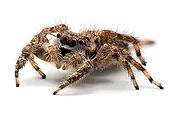
Taxonomy Araneomorphae · Mesothelae · Mygalomorphae · Opisthothelae · List of families of spiders · Lists of spider speciesAnatomy Arthropod leg · Book lung · Calamistrum · Cephalothorax · Chelicerae · Cheliceral fang · Cribellum · Epigyne · Exuvia · Opisthosoma · Pedipalp · Scopulae · Silk · Spinneret · Urticating hairHuman interaction Webs Spider web · Web decorationsCategory General wounds and injuries (T08-T35, 870-949) General Wound/
traumaBlister (Blood blister • Coma blister • Delayed blister • Edema blister • Fracture blister • Friction blister • Sucking blister)
Bruise/Hematoma/Ecchymosis (Battle's sign, Raccoon eyes, Black eye, Subungual hematoma, Cullen's sign, Grey Turner's sign, Retroperitoneal hemorrhage)
Animal bite: Insect bite · Spider biteAnimal bite: Snakebite · Lizard bite
Ballistic traumaForeign body In alimentary tract (Bezoar)Other By region Poisonings, toxicities, and overdoses (T36–T65, 960–989) (history) Inorganic Organic CHOPharmaceuticals cardiovascular systemBiological
(including venom,
toxin,
food poisoning)Other vertebratesList of biting or stinging arthropods: bee sting/bee venom (Apamin, Melittin) · spider venom (Latrotoxin/Latrodectism, Loxoscelism) · scorpion venom (Charybdotoxin)Animal bites and stings (X20, E900-E909) Animal bites and stings Arthropod bites and stings: Arachnid (Scorpion sting, Spider bite/Arachnidism) · Insect bites and stings (Pulicosis, Reduviid bite, Cimicosis, Ant sting, Bee sting) · Myriapoda (Centipede bite, Millipede burn)
Vertebrate: Dog bite · Snakebite · Lizard bite · Stingray injury · Stonefish sting · Shark attack · Crocodile attack · Bear attack · Wolf attack · Tiger attack · Cougar attack · Dingo attack · Killer whale attack
Other: Jellyfish sting/Jellyfish dermatitis (Coral dermatitis, Hydroid dermatitis, Portuguese man-of-war dermatitis, Sea anemone dermatitis, Seabather's eruption)Categories:- Venomous animals
- Animal attacks
- Spiders
- Parasitic infestations, stings, and bites of the skin
Wikimedia Foundation. 2010.


